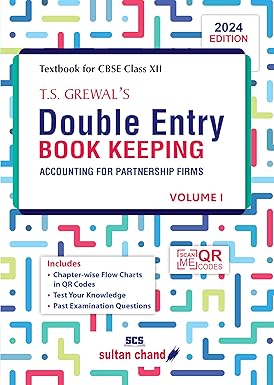Item Details
- Home
- Listed Items
- Items Details
T.S. Grewal's Double Entry Book Keeping (Vol.1)
T.S. Grewal’s Double Entry Book Keeping (Vol. 1) is a comprehensive textbook designed for stude...
- 5-star 0%
- 4-star 0%
- 3-star 0%
- 2-star 0%
- 1-star 0%
Reviews (0)
You need to login to leave a review.
Product Description
T.S. Grewal’s Double Entry Book Keeping (Vol. 1) is a comprehensive textbook designed for stude...
T.S. Grewal’s Double Entry Book Keeping (Vol. 1) is a comprehensive textbook designed for students studying accounting at the senior secondary level, particularly those in Class 11, and is widely used by commerce students across various Indian educational boards like CBSE. The book covers the fundamental principles of accounting, with a focus on the double-entry system, which is the cornerstone of modern accounting practices. Here is a detailed description of its contents and key features:
Key Features:
1. Systematic Approach to Accounting Principles
The book provides a detailed and systematic introduction to the basic concepts of accounting, with a strong emphasis on the double-entry system. This system is essential for maintaining accurate financial records, ensuring that every transaction is recorded in two accounts: a debit in one and a corresponding credit in another. This approach helps students build a solid foundation in accounting and financial management.
2. Comprehensive Coverage of Accounting Concepts
T.S. Grewal’s Double Entry Book Keeping (Vol. 1) covers a wide range of accounting topics, making it a complete resource for students. These include:
- Introduction to Accounting
- Theory Base of Accounting
- Recording of Transactions – Journal Entries
- Ledger Posting
- Cash Book
- Bank Reconciliation Statement
- Trial Balance
- Depreciation Accounting
- Bills of Exchange
- Rectification of Errors
These topics are essential for understanding how businesses record and report financial transactions. Each concept is explained with clarity, using real-life examples and practical problems to help students grasp the concepts better.
3. Step-by-Step Problem-Solving Approach
One of the strengths of the book is its step-by-step approach to solving accounting problems. Each chapter is accompanied by numerous examples, problems, and exercises that illustrate how the principles of accounting are applied in real-life scenarios. The detailed solutions provided help students learn how to approach and solve complex accounting problems with ease.
4. Exercises for Practice
The book offers a wide range of practice exercises at the end of each chapter, including both theoretical questions and practical problems. These exercises are designed to test students’ understanding of the concepts covered in each chapter and give them ample opportunities to practice their problem-solving skills. Many of the exercises reflect the type of questions asked in board exams, making this book an essential resource for exam preparation.
5. Clear and Simple Language
The book is written in a clear and simple language, making it accessible to students who are new to the subject. Each concept is explained in detail without using overly complex terminology, which helps students understand the core principles of accounting without confusion. This makes it suitable for self-study as well as classroom learning.
6. Updated Content as per Latest Syllabus
The book is updated regularly to align with the latest syllabus prescribed by CBSE and other boards. It includes the latest changes in accounting practices, ensuring that students learn accounting methods and standards that are relevant in today’s business world. The current edition also incorporates updates related to GST (Goods and Services Tax) and other modern accounting practices.
7. Illustrative Diagrams and Formats
To help students understand how to present financial statements and accounting records, the book includes illustrative diagrams, formats, and tables. These visual aids demonstrate how to properly prepare balance sheets, ledgers, and cash books, giving students a clear understanding of the format and layout required in accounting documentation.
8. Focus on Financial Literacy
In addition to teaching accounting principles, the book emphasizes the importance of financial literacy. By helping students understand how businesses track income and expenses, the book also prepares them to manage financial transactions in the real world, both personally and professionally.
Benefits:
- Strong Foundation in Accounting: The book helps students build a solid foundation in accounting concepts and practices, making it easier to transition to more advanced accounting studies in the future.
- Exam-Oriented Approach: The book’s structure and content are aligned with the exam patterns of various boards, making it a useful resource for board exam preparation.
- Practical Knowledge: With numerous practical exercises and examples, students gain hands-on experience in applying accounting concepts, ensuring that they are well-prepared for real-world accounting scenarios.
- Conceptual Clarity: The step-by-step explanation and simple language ensure that students have a clear understanding of each topic, allowing them to master the subject with confidence.
Topics Covered in Volume 1:
The first volume of T.S. Grewal’s book focuses primarily on basic accounting principles and the foundational aspects of double-entry bookkeeping. The following topics are covered in detail:
- Chapter 1: Introduction to Accounting
- Meaning, objectives, and advantages of accounting
- Types of accounting information
- Users of accounting information
- Chapter 2: Basic Accounting Terms
- Definitions of important accounting terms such as assets, liabilities, capital, income, expenditure, and more
- Chapter 3: Accounting Principles and Concepts
- Accounting principles, assumptions, and standards
- Dual aspect concept
- Chapter 4: Journal Entries
- Recording transactions in the journal
- Rules of debit and credit
- Chapter 5: Ledger
- Posting journal entries into the ledger
- Balancing ledger accounts
- Chapter 6: Cash Book
- Types of cash books (single, double, triple column)
- Recording cash transactions
- Chapter 7: Bank Reconciliation Statement
- Understanding the purpose of bank reconciliation
- Steps to prepare a bank reconciliation statement
- Chapter 8: Trial Balance
- Objectives of preparing a trial balance
- Errors affecting trial balance
- Chapter 9: Depreciation
- Meaning and need for depreciation
- Methods of calculating depreciation (straight-line and written down value method)
- Chapter 10: Rectification of Errors
- Identifying and rectifying errors in accounting records
- Chapter 11: Bills of Exchange
- Introduction and practical use of bills of exchange
Who Should Use This Book:
- Class 11 Commerce Students: The book is specially designed for Class 11 students who are starting their journey into accounting, helping them grasp the fundamental principles.
- Beginner Accounting Learners: Those who are new to the subject of accounting and bookkeeping will find the explanations simple and easy to understand.
- Teachers and Educators: Teachers can use this book as a textbook and guide for teaching accounting concepts in a structured manner.
Conclusion:
T.S. Grewal’s Double Entry Book Keeping (Vol. 1) is an essential resource for Class 11 students and anyone beginning their journey in accounting. It provides a detailed understanding of accounting principles, focusing on the double-entry system. With its step-by-step approach, ample practice exercises, and easy-to-understand explanations, the book serves as a comprehensive guide to mastering the basics of accounting. Whether used for classroom study or self-study, this book helps students develop the skills necessary to excel in accounting and prepares them for more advanced topics in future studies.







